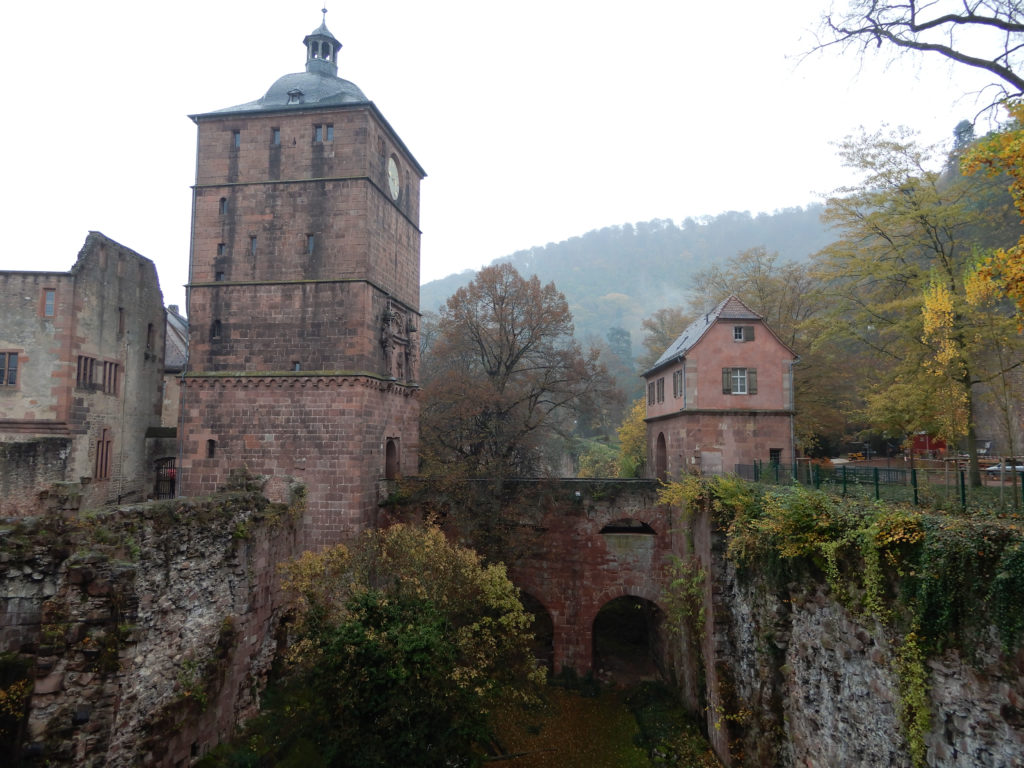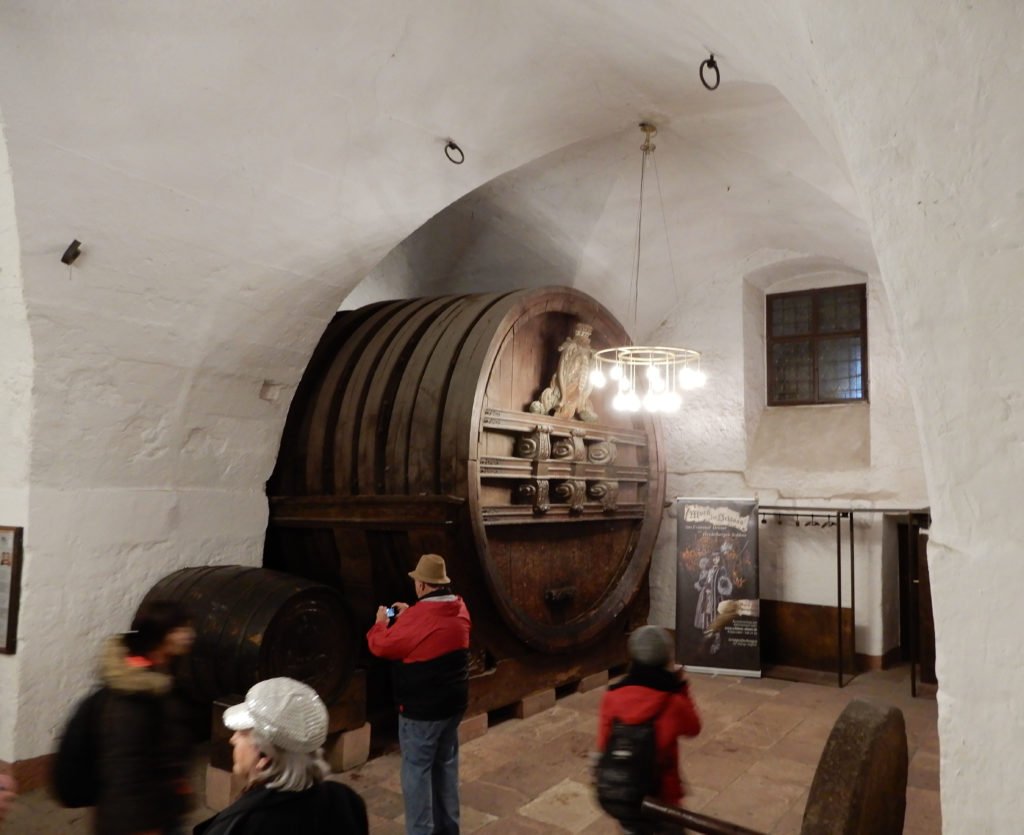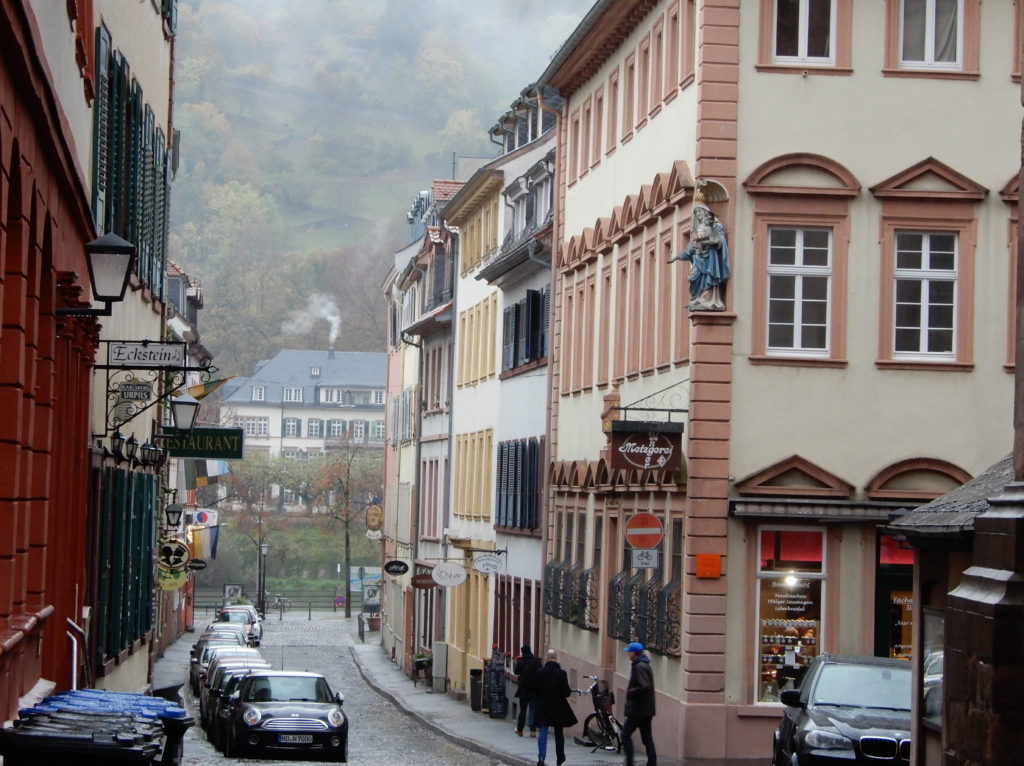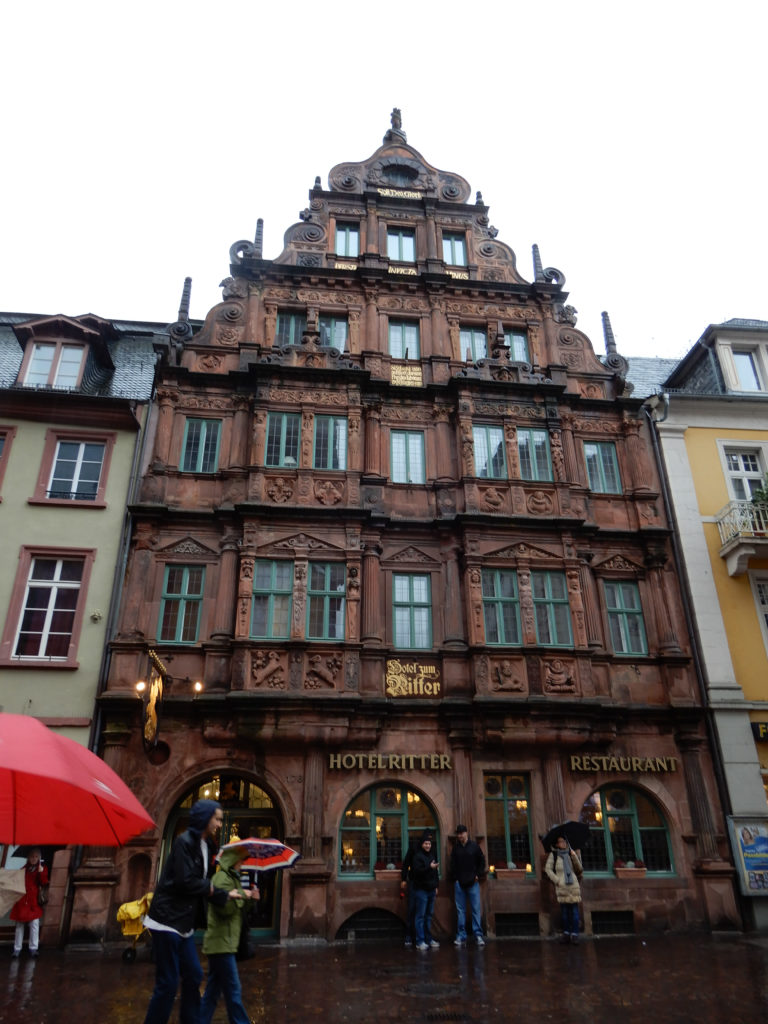The Day Begins in Mannheim
When we woke up our ship was tied up in Mannheim. I am excited today because we will be getting our first taste of touring a real castle with the included tour of Heidelberg Castle. There has been much talk on-board about this beautiful ruin that receives 1.5 million visitors a year, and I am excited to jump into Castle exploration with both feet! The fog and light rain just makes a trip to the castle seem all the more romantic and mysterious.
After fortifying ourselves with a warm cooked-to-order breakfast aboard Kvasir, we grab our audiovoxes and Viking supplied umbrellas and make our way to the motor coaches for a short journey to Heidelberg. It is only 13 miles and takes about 25 minutes from the ship to our first stop, Schloss Heidelberg, or Heidelberg Castle. Our tour guide today is a young American student from Heidelberg University. We unfortunately did not make a note of his name, but he has fantastic knowledge of the castle and the town and we truly appreciated his very American dry sense of humor.
Heidelberg Castle

We are awe-struck by our first sight of Heidelberg Castle by its sheer size, beautiful rose-colored sandstone ramparts, and its graceful placement on a hillside 260 feet above the town. A prior visitor, Mark Twain, also seemed impressed and describes the location of the castle in his 1880 travel book A Tramp Abroad:
“A ruin must be rightly situated, to be effective. This one could not have been better placed. It stands upon a commanding elevation, it is buried in green woods… nature knows how to garnish a ruin to get the best effect.”

The Castle – Schloss Heidelberg
The castle consists of a number of buildings each representing various eras of German architecture. The oldest structure dates back to around 1214. Construction and building over the next few hundred years expanded the castle’s size. Because of construction over such a long span of time, the castle’s architecture represents both Gothic and renaissance styles.
The Queen of Bohemia
Elizabeth Stuart was the daughter of James the King of Scots who rose to rule England Scotland and Ireland. In 1613, After Elizabeth married Frederick V, the Elector Palatinate, they came to Heidelberg Castle. Frederick transformed the castle to make Elizabeth happy. Elizabeth was a fan of the Globe Theater and Shakespeare. Frederick added an “English Wing” that included a large, theater-in-the-round to make his bride happy. He also added a monkey-house, a menagerie and an Italian style Renaissance garden.
Protecting From Invaders
A seriously deep trench surrounds the castle. It’s not clear if this was once a moat filled with water. It also looks like there could have been wild animals patrolling this area to keep invader out.

Passing Through the Guard House
To enter the castle, you must pass through a guard house and then cross a bridge that leads to the main castle and courtyard.

The Inner Courtyard
The Courtyard conjures visions of large gathering of the town’s people and the hustle and bustle of a medieval scene from a movie. Currently many events, gatherings, weddings, and concerts held in the courtyard.
Angels from Heaven
Our guide described how construction of the castle was moving forward quickly until the master architect became grief-stricken over the loss of his two children. Nearly two years went by with the architect in a depression. Finally through pleading and prodding, the architect was convinced that his children in heaven would want and think favorably of him completing the castle. An agreement was struck to place a sculpture of his children in the castle courtyard which got the construction started again.

The Wine Cellar
The “Heidelberg Tun”, the largest wine barrel in the world, dominates the castle wine cellar. The barrel was built in 1751 from 130 oak tree trunks. It measures almost 28 feet across and 23 feet high, and even has a dance floor on top. The barrel will hold 220,000 liters (58,100 gallons) of wine. A practical side was a pipeline from the barrel to the King’s Hall, a large ballroom that allowed wine to be pumped directly into the King’s gatherings.

Ancestral Portrait Gallery
The ancestral portrait gallery is in stone. Entering the courtyard, you are immediately aware of the line of statues on the face of the building that represent the royal line and makes clear Friedrich IV claim to power. Sculptor Sebastian Götz and master builder Johannes Schoch created the figures over a three to four year period in the 17th century.


Lightning Strikes Twice
In 1537, lightening destroyed the upper portions of the castle. Building continued over the next hundred or so years until a series of fires and wars destroyed parts of the castle. Finally, in 1764 another lightning bolt destroyed much of the newly constructed castle. They say lightning never strikes twice; tell that to Heidelberg Castle! Today the castle is pretty much in ruins and much of the interior is off limits.

Heidelberg – The Town
Heidelberg has a rich history and is home to Heidelberg University. Our guide, a student at the University explains it was founded in 1386 and is Germany’s oldest university and also one of the oldest universities in the world. He describes how he decided to attend Heidelberg University moving from America even though he only spoke English. After six months of total immersion, he began to speak and understand German and now is an old hand at it.

I was surprised to learn Heidelberg has nearly 157,000 residents with a quarter of these being students. Our tour only seeing the Altstadt or Old Town skews our perspective of an idyllic 800-year-old small village. Much of the rest of the town’s population, University, major medical center and industry is hidden from our view.
The Marktplatz (Main Square)
The town’s main square is called the Marktplatz. The town is built around the Marktplatz which is bordered by the town hall, the Church of the Holy Spirit, and some shops, restaurants and hotels.

Church of the Holy Spirit
The Church of the Holy Spirit dates back to 1234 being built about 20 years following the original construction of the Castle. It is considered the most famous church in Heidelberg.

Hotel Zum Ritter
The Hotel Zum Ritter was built in 1592 and sits proudly on the Marktplatz across from the town hall and adjacent to the Church of the Holy Spirit. Our tour ends in the Marktplatz in front of the Hotel Zum Ritter. Our guide explains there are public restrooms inside the hotel that they are gracious enough to allow tourists to use. This is important information at this point.

Where to Eat
A quick scan of the square and looking down Hauptstraße Street reveals at least 40 or more places to eat. Being a tourist and college town, there is a huge variety of types of food. Obviously German, but also there was Italian, Indian, Spanish, Kababs, Vietnamese, vegan, and even hamburger and pizza places. Not to be outdone, the restaurants are equaled in number by both coffee houses and Bier Halls.

Lunch at the Bier Brezel

We landed in a wonderful little restaurant called the Bier Brezel for lunch. Established in 1752, the Bier Brezel was a warm, inviting respite from the foggy drizzle.When the hostess first seated us, we were the only customers in the place. By the end of our lunch, the Bier Brezel was hopping with a lively crowd.

The chef took pride in serving a great pizza from the stone oven. This was washed down with delicious frosty German bier. Prost! Cheers!

Peasant’s View of the Castle
Walking down Hauptstraße Street, we stop in a much smaller square, the Kornmarkt. In the center of the square is a statue of the Madonna standing atop of a public fountain. Schloss Heidelberg is perched on a hill 260 feet above the Altstadt (old town) of Heidelberg. I sense what people in the town must have felt nearly 800 years ago seeing the ever looming castle sitting up on the hillside watching over the town below, wondering what the king and queen are doing.

The Sacred Hospital
Looking down at the ground inlaid into the cobblestone are white bricks that outline the shape of a building that once stood on this site in the Kornplatz. There is a historical plaque that reads, (loosely translated) ‘From the end of the 13th century until the year 1557, the chapel of the former sacred-spiritual hospital was located here’. The building outline reveals a building that might hold a huddled mass of 20 people.

Strolling the Town

We stroll down short streets with small shops and some residences on our way back to the bus. The visit to Heidelberg was a fantastic excursion and seemed very different from our first excursions. It is hard to describe, but the feeling of the town, and the pace of the day made today one of the more memorable excursion days on our river cruise.

Like this? Share it on Pinterest. . .

Return to Rhine River Cruise here.

